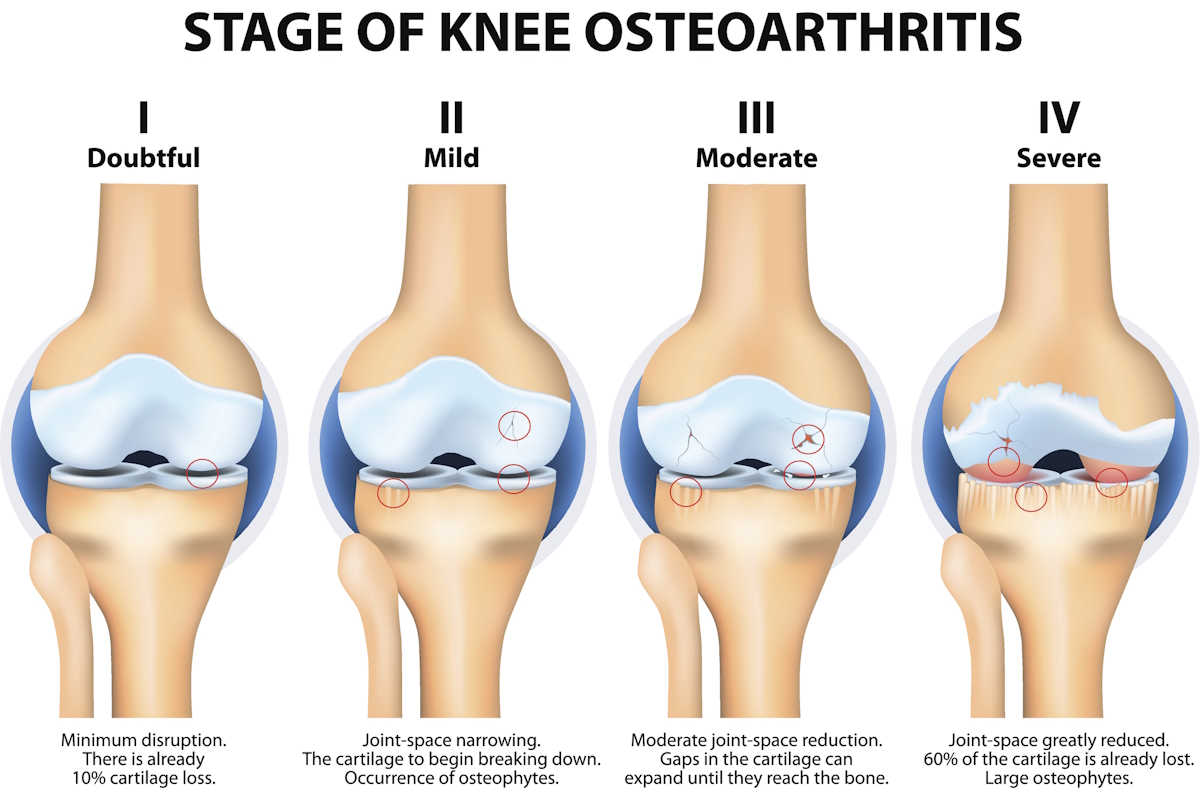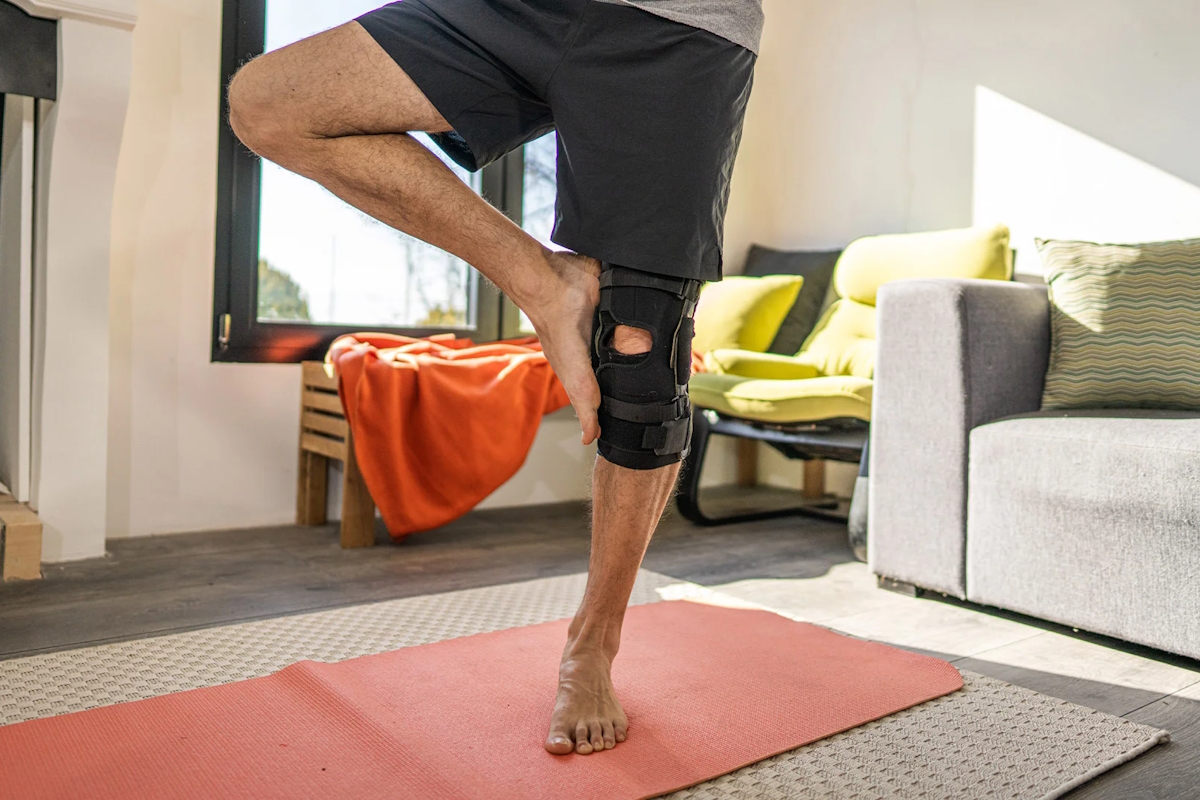Researchers estimate that over 32.5 million U.S. adults have osteoarthritis. This easily makes it one of the leading causes of disability and the most common form of arthritis overall—especially in older adults. And the number of people diagnosed by their doctor is increasing by the day. Clearly, those don’t sound like great odds. So perhaps you’re wondering if knee osteoarthritis can be prevented. In other words, is there anything you can do to ensure that you don’t follow the same path?
Preventing knee osteoarthritis may not be possible. This is a “wear and tear” form of arthritis. Since our knees support most of the body’s weight, they are susceptible to pain, stiffness, and inflammation over time. That said, healthy lifestyle choices, avoiding injury, education on osteoarthritis warning signs, and seeing your doctor regularly could decrease your risk, delay development, and help you manage your knee osteoarthritis symptoms. In addition, there are advances in modern medicine that reduce pain and inflammation for osteoarthritis in the knee.
Why live with osteoarthritis knee pain? Request an appointment with Hamilton Vascular’s specialists. Appointment
What Is Knee Osteoarthritis?
Osteoarthritis is a degenerative joint disease that affects knees and other joints. There currently is no cure, though common treatments such as prescription medication, joint injections, and physical therapy can be highly effective at managing symptoms. In advanced cases, patients may have total or partial knee replacement surgery. Though osteoarthritis can impact the hands and hips, it is very common in the knees, which can become damaged due to injury, overuse, and even disease. As a result, some of the more common symptoms may include:
- Pain in the knee
- Stiffness, especially in the morning or after inactivity
- Decreased range of motion
- Inflammation and swelling
- The knee joint feels unstable or wobbly
- Creaking, crackling, and grating sensations
- Bone spurs
- The knee may lock or stick

Cartilage damage is often the primary concern when it comes to knee osteoarthritis. Cartilage is a strong and flexible connective tissue that, when healthy, acts as a shock absorber, reduces friction, and prevents the bones and joints in the knee and elsewhere from rubbing together. If cartilage is injured or damaged, joints simply don’t work as they used to. Walking up and down stairs could be more challenging, causing constant pain and potentially buckling under pressure. One might struggle to run and jump and possibly hear a constant crackling or grating sensation upon extending the knees. These issues can severely impact a person’s mobility and quality of life.
How Can I Prevent Knee Osteoarthritis?
As previously mentioned, it may not be possible to prevent knee osteoarthritis. We use our knees for bending, lifting, walking, twisting, running, jumping, climbing, and a litany of other daily tasks we often take for granted. On top of that, osteoarthritis is simply one of those debilitating conditions that naturally impacts a person more as they age. Osteoarthritis is most common in people over 50, though younger individuals can experience it.
Other risk factors such as gender and genetics are not in our control. For example, osteoarthritis is more common in women (62% of individuals with OA are women over 45). Per Medline, you can inherit an increased risk of developing knee OA if your parents, older siblings, or even grandparents suffered from it.
If you are concerned about knee osteoarthritis, there are a few things you can be mindful of:
Limit injuries
Injuries from sports or jobs that continually place added pressure on our knees lead to normal wear and tear that can become knee osteoarthritis. Consider warming up and stretching before any athletic activity or long hours on the job. This includes wearing protective braces on the knees and performing strengthening exercises that build up the muscles around the knee joint for increased protection.

Avoid repetitive movements and high-impact activities
Examples of repetitive knee movements can include excessive bending, climbing, and squatting for long periods. While limiting or avoiding these activities can be difficult, it is important to be mindful of how often you do them and give your knees plenty of rest or opt for low-impact exercises if you are experiencing knee pain.
Lose weight
Per WebMD, our knees bear 80% of our body weight when standing still and 150% or more when we walk across a room. For a 160-pound person, that’s 240 pounds of force. Therefore, obesity naturally adds excess stress and weight to your knees. Being overweight also leads to excess inflammation throughout the body.
Stay active
One might think that avoiding activity is the best way to limit excess stress on your knees. But the truth is that increasing activity (especially activities such as walking, swimming, yoga, and cycling) is one of the best ways to keep joints moving, lubricate cartilage, and reduce stiffness and pain in the joint. Staying active also promotes weight loss and enhances energy.
Consider Genicular Artery Embolization for OA Treatment
Sometimes, therapies such as prescription medication, knee injections, and physical therapy simply aren’t enough to provide relief for persistent knee osteoarthritis. And if you want to avoid surgery, you may be left with limited options to improve your situation. This is where Genicular Artery Embolization (GAE) from Hamilton Vascular can help. GAE manages symptoms and gives patients long-lasting relief to improve their quality of life. What makes this even more appealing is that it’s an outpatient procedure that does not require a hospital stay.

What do your arteries have to do with knee osteoarthritis? The key is inflammation. Six genicular arteries in and around the knee supply blood flow to the cruciate ligaments and synovial tissue. By blocking these arteries from distributing blood flow in the areas around the knee, known as synovium, persistent inflammation associated with knee osteoarthritis can be reduced.
Genicular artery embolization could be the answer you’re looking for. We have expert arterial doctors in South Texas ready to help today. Appointment
No incisions. No hospital stays. No painful side effects or downtime.
Here’s how GAE works:
- Patients are given medicine to help them feel sleepy and comfortable during the procedure.
- A small catheter is inserted into the artery in the patient’s upper thigh or ankle. Using X-ray guidance, the arteries receiving blood flow nearest the patient’s pain sight are located.
- With the catheter in position, small particles or agents are injected into the arteries to close them off and stop blood supply to the affected area. This process is 100% painless.
- The result is a quick, significant reduction in inflammation and related symptoms.
GAE is an outpatient procedure and patients can go home within 1-2 hours after GAE. The treatment is painless and takes roughly only 45-60 minutes to complete.
The results of genicular artery embolization have shown this can be a long-lasting therapy to treat patients with symptomatic knee osteoarthritis by reducing synovial arterial hypervascularity. According to one study of 40 subjects over a 10-month period, 100% of those who took part saw dramatic benefits. Another study stated that success has been described to reach 84%–100% of patients.

Hamilton Vascular Can Help With Knee Osteoarthritis
While it may not be possible to prevent knee osteoarthritis, it’s important to know that you have more options for managing your symptoms than steroid injections, physical therapy, medication, and surgery. Inflammation caused by the arteries in and around the knee is often overlooked as a potential culprit for knee osteoarthritis pain. Our advanced Genicular Artery Embolization procedure can provide lasting relief for many of the common wear and tear symptoms you’re currently experiencing.
More good news: treatments are covered by most medical insurances and Medicare. Plus, you can be treated at Hamilton Vascular’s outpatient clinic without ever having to visit the hospital. Hamilton Vascular has long been a leader in performing leading-edge procedures to treat artery and vein disease and symptoms that, while minor in their earliest stages, can eventually lead to more serious and life interrupting issues. The experts at Hamilton will recommend an individualized plan to help you get the best results.
Please contact us at 866-552-4866 or complete the appointment form to schedule a consultation. We are here to help, all while providing compassionate patient care.
AppointmentPrior to starting any new treatment or questions regarding a medical condition, always seek the advice of your doctor or other qualified health provider. This information is not a substitute for professional medical advice.
Hamilton Vascular serves the South Texas region including Houston, San Antonio, Austin, Round Rock, Bastrop, Brushy Creek, Cedar Park, Converse, Georgetown, Hutto, Kyle, Leander, Marble Falls, New Braunfels, Pasadena, Pearland, Pflugerville, San Marcos, Schertz, Houston, Sugar Land, Katy, Webster, Bay City, Clear Lake, Lake Jackson, The Woodlands, Universal City, Spring, Kingwood, Stafford, Conroe, Texas City, Cypress, League City, Bellaire, and more.
*Patient stories are true. Names and/or photos may be changed to protect patient confidentiality.

